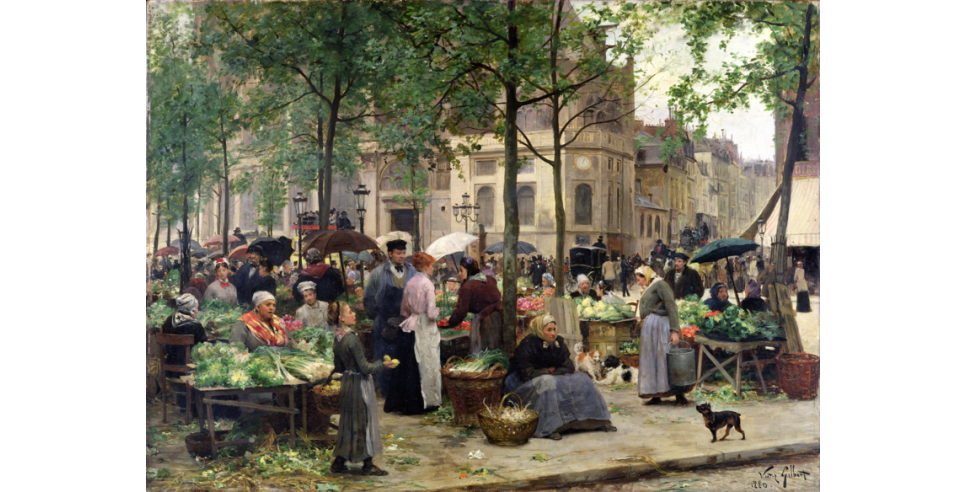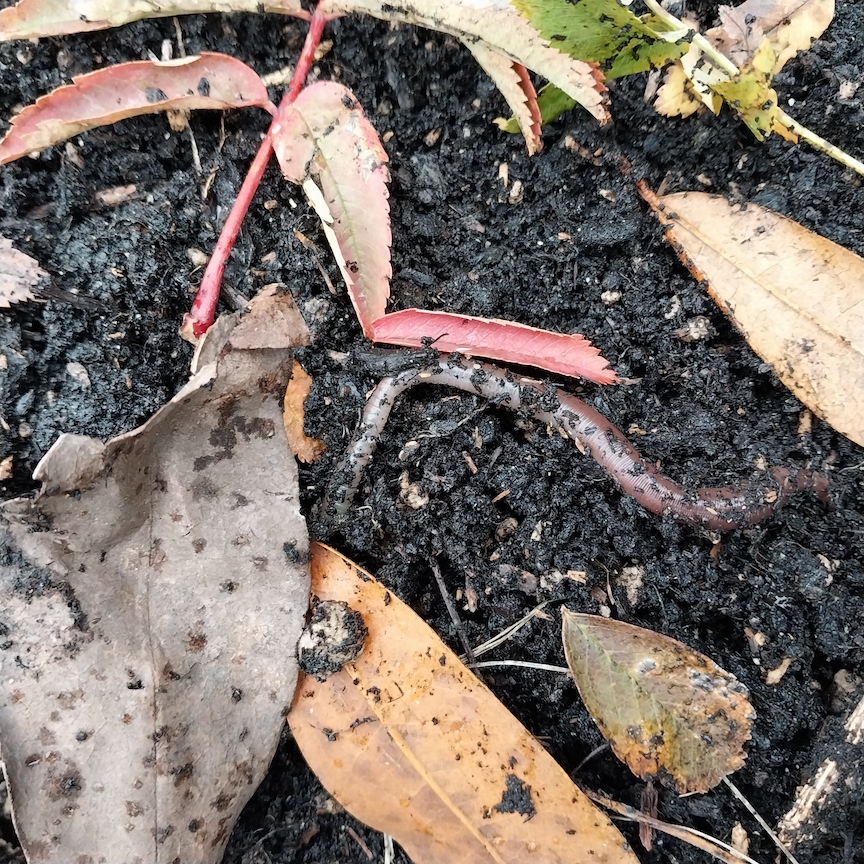
For the past year, a veritable feast of French Impressionist paintings has been touring the United States. Organized in partnership with the American Federation of the Arts and originating at the Chrysler Museum of Art in Norfolk, Virginia, the exhibition called “Farm to Table: Art, Food, and Identity in the Age of Impressionism” was designed to coincide with a worldwide celebration of the 150th anniversary of the first-ever Impressionist exhibition in Paris. Since the exhibition’s debut last fall at the Chrysler, it has gone on to the Frist Art Museum in Nashville and the Cincinnati Art Museum in Ohio. Late last month the exhibit opened at the Seattle Art Museum, where it will be on view until January 18, 2026. Seattle is the show’s final stop.
Works by Impressionist masters including Paul Gauguin, Claude Monet, Camille Pissarro, and Pierre-Auguste Renoir are being displayed on this iteration of the tour, and different sections of the exhibit are devoted to food still-lifes, portrayals of food markets and restaurants, and scenes of farms and harvests.
The most obvious takeaways are those of France’s epic gastronomy, and the energy dedicated to France’s culinary scene. But for all of the gay scenes of cafes and brasseries, and arranged displays of glorious food, the Impressionists also captured darker views – the rat butcher, the child laborer, the gleaners scavenging across harvested fields in search of anything left for their own families. For in 1874 France – then, as now – it was a time of food insecurity, political instability, and economic uncertainty. While some thrived, many others struggled.
One of the most back-breaking scenes portrayed in this exhibit is a small painting in a gold frame. “The Worm Gatherers” was created by artist Eugène Boudin. As the son of a seaman, Boudin was known for his paintings along the coasts of Normandy and Brittany. This oil sketch captures a scene of a half-dozen people or more raking the ground – or perhaps a beach at low tide – to find worms to fill their bait buckets for fishing.
Although there are plenty of rural landscapes in this exhibit, this attention to worm-digging is perhaps the closest the exhibit comes to considering the essential topic of terroir – long a point of distinction for the French, from wines to cheeses. The distinctive conditions of a region – including climate, topography, and especially soil type – affect the taste of the plants that grow there, whether that be grapes in Champagne, or forage in the Roquefort region of southern France known for a particular sheep breed, which then produces the milk that contributes to the unique characteristics of Roquefort cheese.
And yet, the consideration of the very foundation of agriculture, the soil, is missing from this “Farm to Table” traveling exhibition.
So let’s at least give due to the worms, not only for their utility as fish bait, but for the important role they play in soil generation and rejuvenation.
At about the same time the Impressionists were gazing at the world around them and capturing their impressions via brushstrokes on canvas, across the English Channel, Charles Darwin was laboring over what was to be his final significant published work. Years earlier, the naturalist/biologist/geologist had already rocked Western presumptions of creationism with the publication of his book on evolutionary biology, titled “On the Origin of Species.”
But Darwin also had a lifelong interest in the significant work of what many considered the lowliest of creatures, the earthworm. He’d begun researching these terrestrial invertebrates in 1837, and discovered that they were vital engineers for soil health. Over the rest of his life, he kept earthworms in earth-filled pots in his study and searched out earthworms in the fields – investigating how they responded to light, heat, tremors and sound (they seemed equally unimpressed by shouting, whistles and bassoon music). He noted that the earthworms he studied certainly had food preferences – green cabbage over red cabbage, for example, unless the red cabbage leaves were sufficiently wilted. Darwin studied how they enriched soil with their castings, less elegantly known as worm poop, to help build topsoil. With their tunneling activities, they shifted the soil, recycling it in a way that retained moisture. This not only prevented flooding, but also created conditions allowing for increased nitrification and absorption of soluble substances, which then could be picked up by the roots of plants, which aided not only the plants’ health and productivity, but passed along a robust array of nutrients to anyone consuming the plant.
After decades of research, Darwin came out with a book: “The Formation of Vegetable Mould, Through the Action of Worms.” Calling earthworms “nature’s ploughmen,” he went on to assert that, “It may be doubted whether there are many other animals which have played so important a part in the history of the world, as have these lowly organized creatures.”
The book was published in 1883 and, much to the author’s surprise and gratification, it became an instant best-seller – England’s farmers and gardeners were keen to learn more.
 But Darwin died soon after and, sadly, those lessons were forgotten or ignored with the passage of time. By the 20th century, a rapidly increasing global population signaled the imperative to produce more food, and quickly. Perceived efficiencies – highly mechanized agricultural methods, herbicides and insecticides, proprietary crop development that favored high yields/longer storage capability of crops (genetic modification, known as GM)– all combined to overshadow the crucial interlinked relationship between healthy soil, nutrient content in food, and Darwin’s favorite “ploughmen” – the earthworms.
But Darwin died soon after and, sadly, those lessons were forgotten or ignored with the passage of time. By the 20th century, a rapidly increasing global population signaled the imperative to produce more food, and quickly. Perceived efficiencies – highly mechanized agricultural methods, herbicides and insecticides, proprietary crop development that favored high yields/longer storage capability of crops (genetic modification, known as GM)– all combined to overshadow the crucial interlinked relationship between healthy soil, nutrient content in food, and Darwin’s favorite “ploughmen” – the earthworms.
But in 2007, University of Washington geology professor David R. Montgomery sounded the alarm with his book called “Dirt: The Erosion of Civilizations.” Since then he has paired up with his wife, biologist and environmental planner Anne Biklé, to amplify further the evidence that soil health is connected to human health and the overall well-being of the planet’s biological systems.
In the last decade, Montgomery and Biklé have written a trio of books – “The Hidden Half of Nature,” “Growing a Revolution,” and, more recently, “What Your Food Ate” – all of which indict conventional ag business practices as the culprit in this metastasizing debacle. But – more importantly – these books also provide readers with the information they need to advocate for better farming practices. They also give the nudge individuals might need to start right now, one farm or garden at a time, to make regenerative growing practices a reality.
One of the keys to all of this is: allowing earthworms to get back to doing what they’ve always done. According to the nonprofit Soil Association, a British-based advocacy group, worm castings can contain “5 times more nitrogen, 7 times more phosphorus, and 1000 times more beneficial bacteria than the original soil that helps plants grow.”
But by this point in the game, there’s another problem: earthworms across the globe are in dire straits. In the UK, again according to the Soil Association, earthworm populations have been reduced by a third or more in just the last quarter-century. In North America, on the other hand, a 2024 analysis out of Stanford University suggests that over 70 earthworm species imported from elsewhere around the globe are now colonizing swaths of this continent in ways that are altering the natural habitat and hurting indigenous plant, amphibian and insect species.
Those aren’t the only concerns. Aggressive plowing practices on industrially-run farms subject earthworms to mass annihilation. In more populated areas, bulldozers that herald the arrival of every new housing or commercial development unequivocally compact and destroy incalculable numbers of earthworm burrows. And in “What Your Food Ate,” Montgomery/Biklé say that glyphosate, “the world’s most popular herbicide,” is a catastrophe for earthworms, citing research that shows that glyphosate-exposed soils cause earthworms to flee, at best. At worst, the herbicide neutralizes any activity. Other animals, from frogs to rabbits to ducks, also lose their reproductive capacity or simply perish when exposed to this disruptive pesticide. Despite appeals by environmentalists to ban glyphosate, its use is still legal and prevalent in the United States.
The Montgomery/Biklé duo says there’s no point to wallowing in gloom and this is no time to yield to despair.
There are letters that need to be written to policy-makers to promote sustainable farming methods and prohibit use of the most egregious poisons. There are consumer choices that can be made in the aisles of grocery stores (bypass the GM products) and at garden centers (skip the pesticides). Gardeners should leave leaf litter on garden beds through the winter – they provide shelter for beneficial insects and food for earthworms.
Everything you do matters. Everything you don’t do matters, too.
So let’s rewind this runaway train of thought – back from earthworms to terroir – to farm – to table.
However you celebrate your Thanksgiving feast, save room not only for a slice of pie, but also for a round of gratitude. Let that gratitude extend to those who cook our food, who grow our food, and who care for the soil – don’t forget “nature’s ploughmen.”
Barbara Lloyd McMichael is a freelance writer living in the Pacific Northwest









